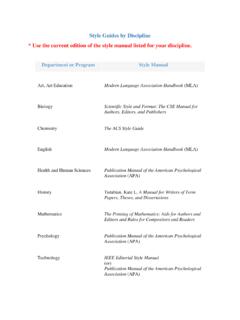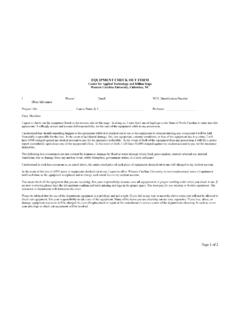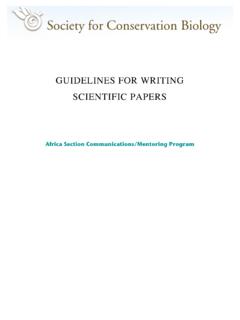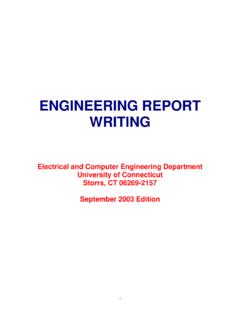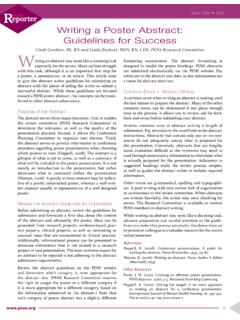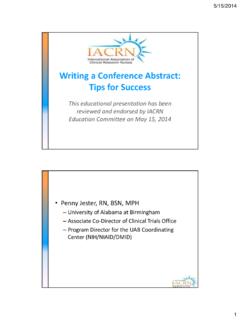Transcription of Writing a Conference Abstract or Proposal
1 Writing a Conference Abstract or Proposal Why you should present at a Conference Network Build your resume Enhance interview potential Advance your scholarship Travel It can be fun! What s a CFP? A CFP is a Conference announcement, also known as a Call for Proposals (CFP). It provides: The Conference theme Guidelines for presentations Requirements for abstracts /proposals Deadlines What is a Conference Proposal ? The Conference Proposal is a stand-alone document independent from your written paper or presentation that proposes your presentation for a Conference . The primary audience for a Conference Proposal is the review committee or Conference organizer. The secondary audience is Conference attendees ( abstracts are generally listed in Conference programs). The purpose of the Proposal is to create a research space for yourself, and to appeal to your primary audiences so it will be accepted! General Guidelines for Responding to the CFP Writing the Proposal / Abstract Define the problem you are addressing clearly and concisely (BONUS: Include key words or phrases from the CFP).
2 Captivate readers with your research description in terms of the problem by: - Providing interesting or controversial perspectives on your topic. - Explaining what your presentation will cover in regard to the topic and problem presented. - Matching your research to the Conference theme/CFP s topics, and making sure the scope of your presentation matches the time allowed for Tips Read the CFP carefully, and be sure to reference it before you submit your Proposal . Adhere to the CFP guidelines. For instance: - Title: Should be descriptive and intriguing (Bonus: Use key words from the CFP if possible.). - Word count: After you have your ideas down, stay within the word count on the CFP (usually between 100-500 words). - Additional information: Provide additional information required in the CFP (usually not included in word count), such as AV equipment and your contact information. - Meet the here to see an example Happy Writing and Happy Presenting!
3 Example Conference Proposal Diane Martinez Assistant Professor Western Carolina University 305 Coulter Bldg., Cullowhee, NC 28723 828-227-3923 Teaching global business communication: Using Bologna Process documentation as a classroom example Although the global workplace allows people the opportunity to work with individuals from all over the world, there is still the challenge of knowing how to effectively represent multiple cultures in professional communication; thus, it is crucial that college students learn various communication approaches and styles for working with multinational groups. Research on global communication has recently gained momentum due to our increasing global economy, and teachers need effective classroom strategies to prepare students for the global workplace. One strategy for teaching about effective global communication is to have students analyze international documents. This strategy is especially insightful for students when the documentation emanates from or serves a multinational group of people.
4 When students are asked to analyze such documentation, it is important to guide them toward careful consideration of the languages, cultures, histories, and politics of concerned parties. To achieve these goals, I use documents from the Bologna Process. Bologna Process documentation is a supreme example of contemporary professional and global communication, and I will share how these documents can be used in the classroom to discuss important aspects of global communication. In my proposed presentation, I will discuss how globalization demands new skills from our students. I address ethical concerns behind various approaches to teaching these new skills, and I share instructional strategies that challenge students to move beyond their generic, and sometimes monocultural, view of business communication and toward approaches that are more culturally inclusive and sensitive.

